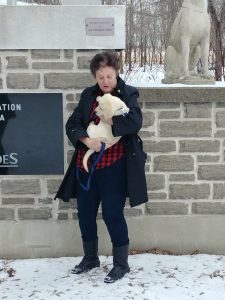Barbara Barr-Haylock was a champion of knowledge for people with PF

It is with great sadness that the Canadian Pulmonary Fibrosis Foundation (CPFF) Board of Directors announces the passing of its Vice-Chair Barbara Barr-Haylock on February 10, 2021.
“She was one of the people, along with the Davidsons, engaged in the early days of CPFF.” says Board Chair Kirk Morrison. “Her historical knowledge of the organization and her perspective as a person living with IPF was invaluable,” says Sharon Lee, CPFF Executive Director. “She will be greatly missed.”
As someone who knew firsthand what it’s like to live with idiopathic pulmonary fibrosis (IPF), and underwent a right-lung transplant in 2017, Barbara worked tirelessly to provide information and education to others affected by this disease. She believed that knowledge is power and she was passionate about educating and helping others dealing with health challenges.
The PF Community offers its heartfelt condolences to Barbara’s husband Malcom Haylock and the rest of her family and friends. You can read more about Barbara in a profile of her in our April 2020 issue.
The family has asked in lieu of flowers to please make a donation to CPFF or to the Lions Foundation of Canada Dog Guides.
CPFF advocating for priority vaccines for people with lung disease

Members of our PF Community have been asking us when they will be able to get the COVID-19 vaccine. CPFF believes individuals with lung disease are at increased risk and need to be near the top of vaccine roll-out lists, which determine when individuals get the vaccine. We are advocating now, along with other members of the COVID-19 Respiratory Roundtable, to ensure people with lung disease get priority access to the vaccine.
CPFF has signed a joint statement of the COVID-19 Respiratory Roundtable, “urging the federal, provincial and territorial governments to prioritize people living with lung disease, who are at higher risk for more serious COVID-19 complications, in the vaccination rollout.”
The joint statement was sent last month, in English and French, to relevant elected officials and public servants, as well as media across Canada. The COVID-19 Respiratory Roundtable is made up of 20 health professional and patient organizations from across the country.
What do you think about Awareness Month 2020?
 As we plan for September 2021 Pulmonary Fibrosis Month (Hope Breathes Here 2021) we want to hear your feedback on last year’s campaign and your ideas for this year’s, so we can keep improving your experience and our content.
As we plan for September 2021 Pulmonary Fibrosis Month (Hope Breathes Here 2021) we want to hear your feedback on last year’s campaign and your ideas for this year’s, so we can keep improving your experience and our content.
Please complete this quick survey and let us know your thoughts. Your responses will remain anonymous.
A rare woman, a rare doctor, a rare disease

Even while she was on oxygen, Dr. Shivani Sharma was worried about who would look after her patients. She was a beloved family physician for more than 30 years, treating her patients with both knowledge and compassion. She passed away on February 9, 2015 from idiopathic pulmonary fibrosis.
Last September, as part of Pulmonary Fibrosis Awareness Month, her son Amit and daughter Shusmita paid tribute to this wise and caring woman and encouraged listeners online to support the Canadian Pulmonary Fibrosis Foundation. Senator Dr. Asha Seth also addressed the audience. You can listen to their remarks here.
Almost 30,000 people in Canada live with pulmonary fibrosis. Each of the 200 types of PF, even IPF, the most common type, is regarded as a rare disease. It’s part of the reason it is often difficult to diagnose the disease and why investment in research and new treatments is so important. Not many people, even physicians, know anything, or much, about the disease.
Sunday, February 28, 2021, is international Rare Disease Day and we invite you to help raise awareness for rare diseases and improve access to treatment and medical representation for individuals with rare diseases and their families. Consider sharing why someone with PF you love is rare and one-of-a-kind.
Visit www.hopebreatheshere.com/stories/ and click on the Share your Story button to add a photo and your story, or that of a family member or friend living with the rare disease of pulmonary fibrosis. You can also draw inspiration from the stories already posted during Pulmonary Fibrosis Awareness Month.
 According to the Rare Disease Day website, there are more than 300 million people around the world living with a rare disease. The website also has other information and stories you may find interesting.
According to the Rare Disease Day website, there are more than 300 million people around the world living with a rare disease. The website also has other information and stories you may find interesting.
A kind and funny man leaves a legacy

Tom Bradley had a reputation as a jokester, always teasing others in a good-natured way. What they spoke about at his funeral last spring was when they were able to “pay” him back.
Like the time someone put a frog in his coffee pot at the cottage. And it was quite a while before he knew who actually did it. Or, the model van with a tiny umbrella clothesline hanging off the back that his co-workers gave him as a gift when he retired. It was a reminder of the day he drove his delivery van across town to the plant with just such a clothesline hanging off the back of his truck. He had leaned it against the truck, while replacing it with a new one.
One of the youngest of 15 siblings, Tom was born and raised in Arnstein, Ontario, near North Bay. After graduation, he headed to Ottawa to work, where he met his wife Lise Senechal and they married in 1967. He spent most of his working life with Pepsico and retired at 55. He and his wife had a home in Florida, where they spent the winters.
The couple had no children, but many nieces and nephews. “He was always happy to help anyone out,” says Ginette Senechal, his sister-in-law. “And he didn’t change much during his life,” says Ginette, who knew him for almost 60 years. “He didn’t drink or smoke, and was always quite fit. He was a wonderful husband and brother-in-law, and always had his great sense of humour.”

As a young man, Tom played several sports, including hockey and baseball and also curled. Later in life he became an avid golfer, and was excited to finally get a hole in one a couple of years before he died at 75. Throughout his life, was an avid fan of the Habs and it was appropriate that he was buried in his Montreal Canadiens jersey.
Unfortunately, Lise died of cancer in 2015. Not long afterwards, Tom noticed a persistent cough, but it took a while before he received a diagnosis of pulmonary fibrosis. During a trip to Newfoundland in 2019 he experienced an acute exacerbation, and once stabilized in hospital, needed to pay for a medical airlift home to the Ottawa area.
Although he was excited to learn there was no age limit for a lung transplant, his assessment showed he was not a good candidate. He found the care he received at the Ottawa General Hospital exceptional and spent his last days in the Elisabeth Bruyère Palliative Care Unit.
This kind and funny man will be missed by his extended family and friends and his partner Ruth-Anne Stirling. In his will, Tom left a substantial bequest to the Canadian Pulmonary Fibrosis Foundation. His legacy to CPFF will be used to help others living with pulmonary fibrosis.
“Many people living with pulmonary fibrosis reach out to us for support and information, sometimes just online,” says Sharon Lee, Executive Director of CPFF. “If they are able, they decide to give back and help others living with the disease. And for this, CPFF is grateful to all of our donors.”
If you are interested in leaving a bequest to CPFF, speak to your lawyer, or reach out to Sharon at [email protected] for more information.
COVID-19 impacts research efforts too

While we all continue to struggle with the restrictions imposed by COVID-19, and health care workers do their best to cope with rising caseloads, researchers too are finding that some of their work has been put on pause until the COVID cases come down in their centres.
“We are definitely ready to get going as soon as the COVID cases come down enough in our center, which I’m optimistic will happen soon,” says Dr. Dmitry Rozenberg, Clinical Scientist at Toronto General Hospital Research Institute, Assistant Professor at the University of Toronto and co-principal investigator on a CPFF-funded research study on muscle changes during and after hospitalization for an acute exacerbation in interstitial lung disease (AE-ILD) patients. “We have informed the multidisciplinary team about the study and research personnel have been trained.”

Dr. Reid, a professor at the University of Toronto, KITE Rehab Institute Senior Scientist and the other co-principal investigator, agrees that the study is set to go. “Our methodology is ready and has been piloted on individual adults, and we’ve refined our procedures,” she says. And during the COVID restrictions, they’ve done a scoping review of the scientific literature to see if others have investigated the same topic. “We found only three papers of the 1,300 we reviewed that were related to ILD. So, this will be quite a unique investigation, using some state-of-the-art technology.”
The pilot study: “Is Muscle Dysfunction and Oxidative Stress in Acute Exacerbations of Interstitial Lung Disease Predictive of Clinical Outcomes?” will measure the diaphragm (the major breathing muscle) and thigh muscles in 20 ILD patients while in hospital for AE-ILD and three months after discharge. Their results will be compared to 10 control ILD patients, who are undergoing transplant assessment.
Overall, people with ILD have a greatly reduced exercise capacity; 50 per cent of normal during the six-minute walk test and physical activity levels about one-third of those of healthy people. “We need to have a better understanding of how exercise impacts the oxygen status of muscle in ILD, especially in those with severe disease,” says Dr. Reid.
The diaphragm will be measured using ultrasound and the thigh will be measured using a new technology called near infrared spectroscopy (NIRS), a device that evaluates oxygen status of the tissues. “It is like an oximeter for the tissues,” says Dr. Reid. It also provides real time measures of hemodynamics, oxygenation and deoxygenation of the muscle. “This information can provide important insights into the limitations of exercise in people with ILD.” NIRS is non-invasive, being secured to the skin above the muscle and takes measurements while the muscle is in motion. Blood tests will also be administered to measure oxidative stress on skeletal muscle during AE-IPF and three months following discharge.
We recently conducted a study reviewing charts on 89 patients admitted to Toronto General Hospital Respirology Ward with an AE-ILD over 5 years (2015 to 2019). The mean age was 67; 61 per cent were male, and 63 per cent had IPF. The median hospital stay was nine days for this group. Approximately one-third of ILD patients were dependent for instrumental activities of daily living (i.e. groceries, banking) before hospitalization and about one-third required physiotherapy support during hospitalization. Unfortunately, one-fifth of patients died during hospitalization. Of those surviving to hospital discharge, about 20 per cent required additional support services on discharge highlighting the functional limitations imposed by AE-ILD.
As with other ILD research, especially studies involving in-person patient contact, research practices have had to be modified to adhere to important safety precautions including personal protective equipment and appropriate distancing. Furthermore, all outpatient in person research visits need to align with clinical care visits to reduce any additional travel and potential COVID-19 exposure in this vulnerable ILD population.
“This has definitely been the most challenging time of my career,” says Dr. Reid, who is also a physiotherapist. “Some staff are very stressed, both at work and at home. In respiratory care, staff and patients are at greater risk because of the possibility of COVID-19.”
Dr. Rozenberg, who is a clinician and a researcher, has been spending more time caring for patients, including people with COVID-19. This has created new avenues to practice and deliver clinical care, especially virtually. They have applied many of these approaches to research.
Both researchers are optimistic that they will be able to proceed with the study soon. They are certain the results will be a foundation for further investigation into the optimum type and amount of exercise that will help people with ILD maintain mobility and independence and enjoy their lives to the best of their ability. “When prescribing the type and amount of exercise, it is a fine balance between improving physical fitness and avoiding fatigue and breathlessness,” says Dr. Reid.
“We are also grateful for the support of CPFF for our study. The results from this study should open the door to larger grants and studies. It also offers a wonderful research opportunity for our post-doc fellows. And, ultimately we hope this will help improve the lives of people living with ILD.”
Editors note: Once the study is completed, we will report the results in this newsletter.
New webinar “Therapies for IPF from Pills to Lung Transplantation” now online

If you missed the live broadcast last month, you can now visit CPFF’s Hope Breathes Here website to hear Dr. Shane Shapera and Dr. Shaf Keshavjee share their expert insights on therapies for idiopathic pulmonary fibrosis, including lung transplantation. They also answer several questions from the audience of more than 300 patients and caregivers, who attended this education session virtually.

In his talk, Dr. Shapera provides background information about Interstitial Lung Disease (ILD) and Idiopathic Pulmonary Fibrosis (IPF). He explains how medical experts use forced vital capacity (FVC) to monitor disease progression and reviews general principles of treatment for all chronic lung disease. Finally, he shares the data behind IPF-specific treatment recommendations.
After some brief descriptions of ILD and IPF, he notes that every patient’s IPF experience is unique to them. Some are stable for a very long time. Others will deteriorate quickly and still others will be stable for some time and then drop quickly and drastically with an acute worsening of the disease.
Dr. Shapera outlines some of the general principles of treatment for all chronic lung diseases:
- Stop smoking. IPF is associated with an increased risk of lung cancer and IPF and smoking combined significantly increases your risk. IPF combined with emphysema, often the result of smoking, increases your risk of needing supplemental oxygen, increases your risk of complications like pulmonary hypertension and can shorten your life.
- Pulmonary rehabilitation. The primary goal of pulmonary rehab is to improve your muscle strength and cardiovascular fitness. It can also improve your knowledge about living with lung disease and reduce social and emotional isolation. While your lungs will not “get stronger” (as an organ they cannot to do so) the exercises help your muscles to function efficiently in a low oxygen environment.
- Oxygen therapy. If your oxygen levels are low at rest, then oxygen therapy is recommended. If your oxygen levels only drop with physical activity, you should discuss with your doctor whether oxygen therapy can help you remain more active.
- Psychosocial aspects. Support groups provide education and support and reduce social isolation. Refer to reputable websites for information, like cpff.ca. (A review of 100 top websites on IPF, found that about 50 per cent had incomplete or incorrect information.) And don’t ignore depression. It affects up to 25 per cent of patients. Early referral to a psychologist or psychiatrist can help reduce the mental, emotional and physical impacts of depression.
- Get vaccinated. Along with seasonal flu and pneumonia vaccines, Dr. Shapera is adamant that everyone with IPF should get the COVID-19 vaccine as soon as possible.
“The risks of the COVID-19 vaccines are very minor compared to the substantial increased risk of death among people with ILD or IPF,” he says, referring to a recent European analysis of 161 people hospitalized with COVID-19 between March and May of 2020. The study found that patients with ILD had a high mortality from COVID-19, at 49 per cent, compared to 35 per cent for those without ILD. And patients with IPF had a mortality rate of 60 per cent.
In his review of treatments specifically for IPF, Dr. Shapera noted the changes in recommendations, especially since the discovery and approval of two anti-fibrotic medications pirfenidone (Esbriet™) and nintedanib (Ofev™). Both drugs have undergone extensive study and slow the decline in forced vital capacity (FVC) by similar amounts. The main difference for the patient lies in their side effects, which should be considered in how they may impact your quality of life.
“A truck driver may not choose nintedanib, since it’s main side effect is diarrhea,” says Dr. Shapera, “and a golf pro may not choose pirfenidone, since sun exposure can cause a rash. Both drugs are equally effective, the choice is really a matter of patient preference.”
Dr. Shapera noted that at least four new IPF medications are in development, but will not likely be available for at least two to four years.
A lung transplant is the final treatment option for people with IPF. In the second part of this webinar, Dr. Shaf Keshavjee shares his deep expertise on lung transplants. He gives an overview of the Toronto Lung Transplant Program at the University Health Network (UHN), lung transplant trends over decades, transplant patient survival rates, the process for organ selection and management, innovations and the future of transplantation.
Here are some of the quick facts he presented about lung transplantation:
- Toronto performed the first lung transplant in the world in 1983 (on a person with IPF) and still performs the most lung transplants in the world.
- There is no age limit today for a lung transplant. Many people are over 70. Selection is now based on who is most likely to survive the surgery and have a decent quality of life following the transplant.
- For people with IPF, the median (half more and half less) survival after transplant is 6.34 years.
- In the 1980s doctors told transplant patients they had a 50/50 chance of surviving the surgery. That dropped considerably in the 1990s and continued to drop to the current number, with 98 per cent surviving the surgery.
- Of 212 lung transplants performed in Toronto in 2019, just 1.4 per cent did not survive surgery.
Dr. Keshavjee is also pleased to say that just weeks before the webinar he met a woman who had received her new lungs 29 years ago! So, many survive well beyond the median survival rate.
He also describes how researchers addressed the number of lungs which were once deemed unfit for transplant – up to 80 per cent of the lungs donated before 2008. With the innovation of the Ex Vivo Lung Perfusion, (EVLP) a “mini ICU for the lungs” while outside a body, the progress in lung transplantation has been significant.
Developed by the Toronto Lung Transplant Program, EVLP means lungs can survive up to three days outside of a human being and can be repaired and even improved for transplant. Dr. Keshavjee described how once unsuitable lungs can be assessed and treated for clots, Hepatitis C, or other injuries and conditions before transplantation.
Donor lungs can also now be treated with gene therapies, so that they become more like the recipient’s own lungs to help reduce the risk of rejection. “We are finding ways to target these gene therapies, so they can be delivered exactly where we want them to go,” adds Dr. Keshavjee.
In the future, he sees donated organs (not just lungs), going to “organ repair centres” to be assessed and treated, before being shipped out to receiving hospitals. Such a centre already exists in the US, serving 16 medical centres. “Using EVLP, these organ repair centres will eliminate the need for each transplanting hospital to have it own EVLP operating rooms with the necessary staff,” says Keshavjee. “In these centres, a number of small EVLP units in each room can be overseen by a single specialist.”
He also speaks about new modes of transportation of lungs. Today they are shipped by land or air. But at UHN, they have tested moving “model” lungs using a drone between the Toronto Western Hospital and Toronto General Hospital. “They only weigh about 2 kilos,” says Keshavjee, “why not try using drones.”
And, the lung assessment/diagnosis tests from the lung transplant program is being studied for use in COVID-19 testing in the Emergency Room. “Part of the problem in the ER is being able to distinguish which COVID-19 patients will generate a response that attacks the lungs and requires hospital care. The lung transplant program’s lung assessment testing may be adapted for COVID-19 testing in the ER and reduce the number of admissions to only those who need it.”
If you ‘d like more details about the information provided in this article, and to hear the questions and answers provided in the live broadcast, be sure to access the online version of this fascinating webinar.
“CPFF would like to express its gratitude to both Drs. Shapera and Keshavjee for taking the time to prepare and share their expertise with our PF Community in this webinar,” says Sharon Lee, CPFF Executive Director. “We’d also like to take this moment to thank them – and their teams – for all that they do to improve the lives of people living with PF and their families.”


